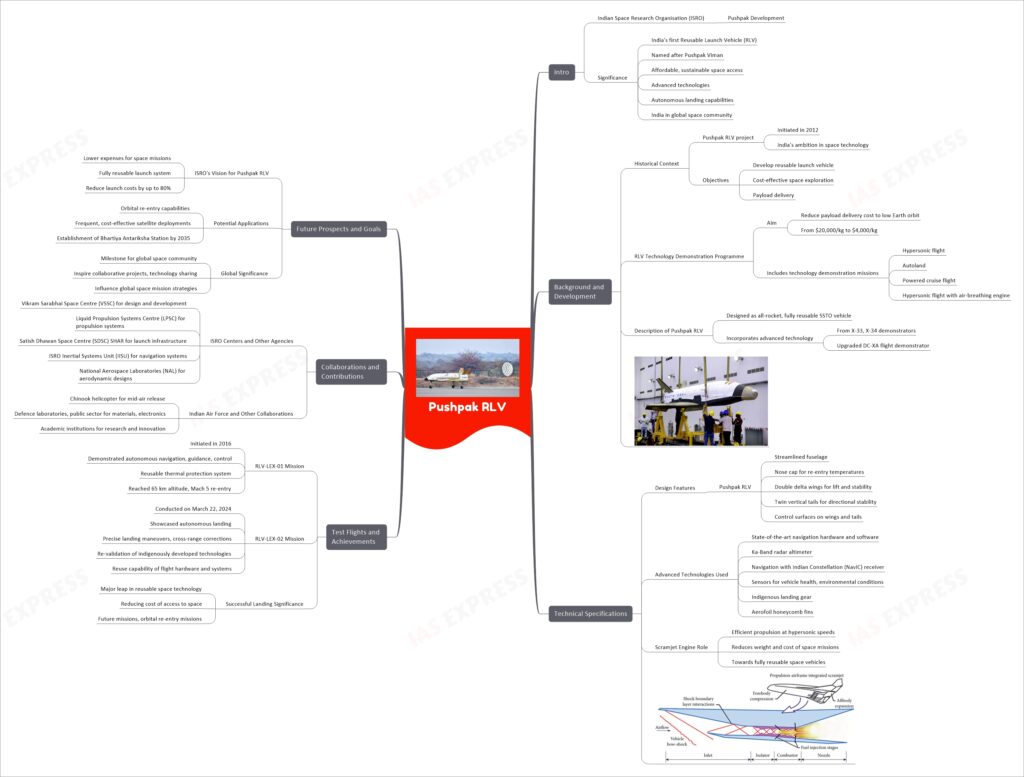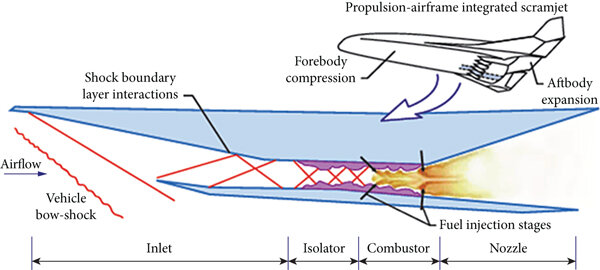[Indepth] Pushpak – ISRO’s Reusable Launch Vehicle
The Indian Space Research Organisation (ISRO) has achieved a significant milestone with the successful development and landing of Pushpak, India’s first Reusable Launch Vehicle (RLV). This groundbreaking project, named after the mythical ‘Pushpak Viman’, represents a leap towards making space access more affordable and sustainable. Incorporating advanced technologies and demonstrating autonomous landing capabilities, Pushpak paves the way for future space exploration and positions India as a key player in the global space community.
This topic of “[Indepth] Pushpak – ISRO’s Reusable Launch Vehicle” is important from the perspective of the UPSC IAS Examination, which falls under General Studies Portion.
Background and Development:
- Historical context:
- The Pushpak RLV project was initiated in 2012, marking a significant step towards India’s ambition in space technology.
- Its primary objectives include the development of technologies for a reusable launch vehicle to ensure cost-effective space exploration and payload delivery.
- Overview of the RLV Technology Demonstration Programme:
- Aimed at reducing the cost of payload delivery to low Earth orbit by 80%, from the existing $20,000/kg to $4,000/kg.
- The programme includes a series of technology demonstration missions to test various aspects such as hypersonic flight, autoland, powered cruise flight, and hypersonic flight using air-breathing engine propulsion.
- Description of the Pushpak RLV:
- Designed as an all-rocket, fully reusable single-stage-to-orbit (SSTO) vehicle.
- Incorporates advanced technology from previous demonstrators, including elements from the X-33 advanced technology demonstrator, the X-34 testbed technology demonstrator, and the upgraded DC-XA flight demonstrator.
Technical Specifications
- Design features:
- The Pushpak RLV boasts a streamlined fuselage designed for optimal aerodynamics during both ascent and re-entry phases.
- Equipped with a nose cap that can withstand extreme temperatures encountered during re-entry into Earth’s atmosphere.
- Features double delta wings which enhance lift and stability across a wide range of speeds, crucial for re-entry and landing maneuvers.
- Includes twin vertical tails that improve directional stability, essential for the control of the vehicle during flight.
- Incorporates control surfaces on the wings and tails, allowing for precise maneuvering and control throughout the flight envelope.
- Advanced technologies used:
- Utilizes state-of-the-art navigation hardware and software, ensuring accurate guidance, navigation, and control throughout the mission.
- Equipped with a Ka-Band radar altimeter, providing precise altitude measurements critical for landing operations.
- Features a Navigation with Indian Constellation (NavIC) receiver, leveraging India’s regional satellite navigation system for enhanced positioning accuracy.
- Includes various sensors for monitoring vehicle health, environmental conditions, and performance metrics in real-time.
- Employs indigenous landing gear designed to withstand the stresses of landing, demonstrating ISRO’s capability in developing critical technologies domestically.
- Utilizes aerofoil honeycomb fins, contributing to the vehicle’s aerodynamic efficiency and thermal protection.
- The role of the scramjet engine in the future development of Pushpak and its significance:
- The scramjet engine represents a pivotal advancement for Pushpak, enabling efficient propulsion at hypersonic speeds by utilizing atmospheric oxygen instead of carrying oxidizers.
- This technology is expected to significantly reduce the weight and cost of space missions, making space access more affordable and sustainable.
- The successful integration and operation of scramjet engines in Pushpak will mark a major leap towards the realization of fully reusable space vehicles, enhancing ISRO’s capabilities in space exploration and satellite deployment.
Test Flights and Achievements
- Summary of the RLV-LEX-01 mission and its outcomes:
- Initiated as a pioneering endeavor in 2016, the RLV-LEX-01 mission marked ISRO’s initial foray into testing Reusable Launch Vehicle technology.
- The mission’s primary achievement was the demonstration of critical technologies such as autonomous navigation, guidance, control, and a reusable thermal protection system during a suborbital flight that reached a peak altitude of approximately 65 km.
- The vehicle, after separating from the launch rocket, successfully re-entered the Earth’s atmosphere at speeds around Mach 5, validating ISRO’s capabilities in managing high-speed atmospheric re-entry.
- Detailed account of the RLV-LEX-02 mission: Autonomous landing capabilities, challenging maneuvers, and the re-validation of indigenously developed technologies:
- Conducted on March 22, 2024, the RLV-LEX-02 mission showcased the autonomous landing prowess of the RLV, named Pushpak, from a release altitude of 4.5 km by an Indian Air Force Chinook helicopter.
- This mission was characterized by Pushpak executing precise landing maneuvers and cross-range corrections autonomously, simulating the conditions of a space vehicle returning to Earth.
- A significant aspect of this mission was the re-validation of indigenously developed technologies in navigation, control systems, landing gear, and deceleration systems, crucial for the high-speed autonomous landing of space-returning vehicles.
- The successful reuse of the winged body and all flight systems from the RLV-LEX-01 mission in the RLV-LEX-02 mission, after necessary certifications, underscored the reuse capability of flight hardware and systems.
- The significance of the successful landing of Pushpak on March 22, 2024, and its implications for future space exploration:
- The triumphant landing of Pushpak not only signifies a major leap in ISRO’s quest for developing reusable space technology but also positions India as a formidable player in the global arena of space exploration.
- This achievement paves the way for reducing the cost of access to space, making space exploration more sustainable and economically viable.
- Looking ahead, the successful implementation of RLV technology is expected to facilitate future missions, including orbital re-entry missions, and lay the groundwork for India’s ambitions in establishing a more permanent presence in space.
Collaborations and Contributions
- The role of various ISRO centers and other agencies in the development and success of the Pushpak missions:
- The Vikram Sarabhai Space Centre (VSSC) played a pivotal role in the design and development of the Pushpak RLV, contributing its expertise in aerospace technologies.
- Liquid Propulsion Systems Centre (LPSC) was instrumental in the development of propulsion systems that are critical for the RLV’s operations.
- The Satish Dhawan Space Centre (SDSC) SHAR provided the necessary launch infrastructure and range support for the test flights.
- ISRO Inertial Systems Unit (IISU) in Thiruvananthapuram contributed to the navigation and inertial systems of the vehicle.
- The National Aerospace Laboratories (NAL), along with other academic institutions, supported the development of aerodynamic designs and materials.
- Contributions of the Indian Air Force and the collaboration with other research and development organizations:
- The Indian Air Force provided critical support in the form of a Chinook helicopter for the mid-air release of Pushpak during the RLV-LEX-02 mission, demonstrating the vehicle’s autonomous landing capabilities.
- Collaborations with defence laboratories and public sector undertakings contributed to the development of advanced materials and electronic systems.
- Partnerships with academic institutions facilitated research and innovation in areas such as thermal protection systems and hypersonic flight dynamics.
Future Prospects and Goals
- ISRO’s vision for the Pushpak RLV in reducing the cost of space missions and enabling low-cost access to space:
- ISRO envisions the Pushpak RLV as a transformative technology aimed at dramatically lowering the expenses associated with space missions.
- By developing a fully reusable launch system, ISRO aims to revolutionize space exploration, making it more affordable and sustainable for India and potentially for global partners.
- The reusability aspect of Pushpak is expected to reduce launch costs by up to 80%, thereby democratizing access to space and fostering a new era of space exploration and utilization.
- Potential applications of the Pushpak RLV in future space exploration missions, including orbital re-entry capabilities and the establishment of the Bhartiya Antariksha Station by 2035:
- The Pushpak RLV is designed to support a wide range of future space exploration missions, with orbital re-entry capabilities being a key focus.
- This technology will enable more frequent and cost-effective satellite deployments, space research missions, and potentially crewed missions in the future.
- ISRO’s ambitious plan includes utilizing the Pushpak RLV for the establishment of the Bhartiya Antariksha Station by 2035, marking a significant step towards India’s long-term presence in space.
- The global significance of Pushpak in the context of reusable launch vehicle technology and its potential impact on the international space community:
- The Pushpak RLV represents a significant milestone not just for ISRO but for the global space community, showcasing India’s growing prowess in space technology.
- Its success and further development could inspire collaborative projects and technology sharing between nations, enhancing global efforts towards sustainable space exploration.
- The innovations and cost reductions achieved through Pushpak could influence global space mission strategies, making space more accessible and encouraging a new wave of exploration and utilization.
Conclusion
The successful development and operation of ISRO’s Pushpak RLV mark a pivotal advancement in space technology, heralding a new era of cost-effective and sustainable space exploration. This achievement not only underscores India’s growing capabilities in aerospace but also promises to reshape the global landscape of space missions. As ISRO continues to innovate, the implications of Pushpak’s success extend far beyond national pride, potentially revolutionizing access to space on an international scale.
Practice Question
Evaluate the significance of ISRO’s Pushpak Reusable Launch Vehicle (RLV) in the context of sustainable space exploration and its potential impact on India’s position in the global space community. (250 words)




